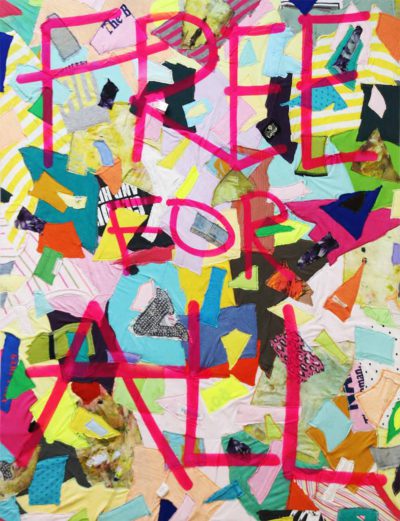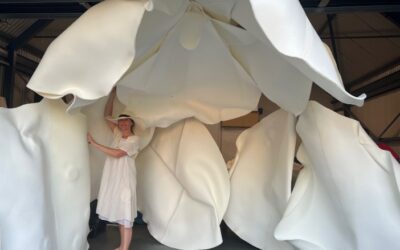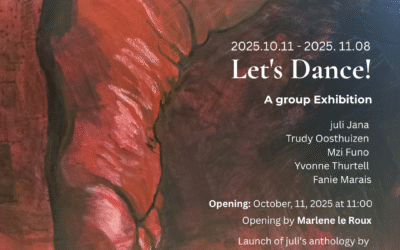Danny Shorkend reviews Creative Destruction, a group exhibition, on show at Eclectica Contemporary.
In order for the creative act to take place, there often has to be both a constructive and destructive element. In order for there to be new, creative births if you will, often there has to be a dismantling of the known and established in order to create something novel – and hopefully better.
This is no more apt in a South African context, where a new social order has grown and continues to grow on the ashes and waste of the past.
Art is often entrusted with expressing and even shaping this new way of thinking around social structures and interrogating what such changes may mean. This exhibition, while not always easy to find a common thread, appears to sit on the cusp of a deconstructive attitude as well as a hope and change for a better social fabric.
What is particularly pleasing is the variety of aesthetic methods employed.
Ngqinambi’s oil painting at once speaks of chaos and terrible struggle, as well as motion towards a completely new place, a sort of journey to something as yet undefined. There is a sense of mobility, of a “trek” to a new place, even as this is fraught with danger and impending doom. His use of brushmark and pulsating beams of light that seep through the gloom suggests all is not lost, that as his “Scroll’s” painting indicate, history or historical records will not be lost, and even though his journey appears fraught with danger, a new destination imbued with meaning will be found.
Daya Heller’s “Life Cycle”, a resin installation with little “tear drops” bearing fynbos is quite beautiful. Here, instead of the journey to a new place, there appears to be a memorialising of the past, as if the little plants – nature – are kept untainted and rendered permanent. These little shapes encase the fynbos as if to both capture life and impending death, an arresting of the usual life cycle if only to emphasise that cycle in the first place. What shall be preserved and remembered; what shall be renewed and revived? This may have implications spanning the biological, artistic and political so that this installation is a fresh recreation of – or meditation on – the process of change and stasis at one and the same time.
Jeanette Unite’s consistent focus on mining (and her utilising of minerals and by-products from the mining industry) is relevant in a South African (and global) context as it is precisely the use of nature for material benefit that often determines the wealth of the nation state. It is unclear whether economic principles that outline the use of such resources (and certain legal texts are embedded in her work) serves or benefits only a few or whether the people benefit from the potential wealth. Considering the calamities that have occurred at such sites, the equation is that much more complex. Her well-worked surfaces, imbued both with a sense of apocalyptic climax as well as the acidic, textured light of the energised surfaces suggest a resolution to the problem of human and natural resources – both in terms of economics and industry – is not forthcoming.
The exhibition continues downstairs in the grunge-like, alternative space wherein one is greeted with some curious works. An installation by Chris van Eeden, a kind of “Raft on Medusa”, only the “sculpture” is not necessarily about equality and liberty and freedom, but possibly about the abstraction of humans through the labour process and competitive capitalism, that as solidity “melts into air” as Marx and Engel’s once put it, so that there is alienation from man’s productive labour as the so-called free market reduces all – in some respects at least – to objects. That indeed the artist’s use of fabric and non-classical materials if you will, is an indictment of apparent coherence that the ruling regime (and I am not sure to whom this refers) may sell to the public. Essentially, the installation reminds one of alternative, symbolic structures that in themselves decry the very notion of an army and the follower, the flag bearer and gun wielder.
There are a number of other tantalising works on display and a general sense of the energised body in motion (in particular Ley Maboramwe’s acrylics on canvas) so that there is a reclamation of the body as a site for creative change, even as there is a sense of the body’s disappearance into abstraction, rules, economic gain, aesthetisiced play and the visual succumbing to text (consider Tlabela’s work in this regard) – so that such dichotomies perhaps acknowledge that the creative act is both joyous and painful, potentially inspiring and imagining new possibilities. Art may also well be critical, destructive and deconstructive – a very human search for meaning amidst a seeming Sisyphean struggle.
Well worth a visit.
WHERE: Eclectica Contemporary, 9 Burg Street, Cape Town 8001
WHAT: CREATIVE DESTRUCTION: A group exhibition
WHEN:Until 12th January
Review by DANNY SHORKEND first appeared in the Cape Times
PHOTO: artist Chris Van Heerden






